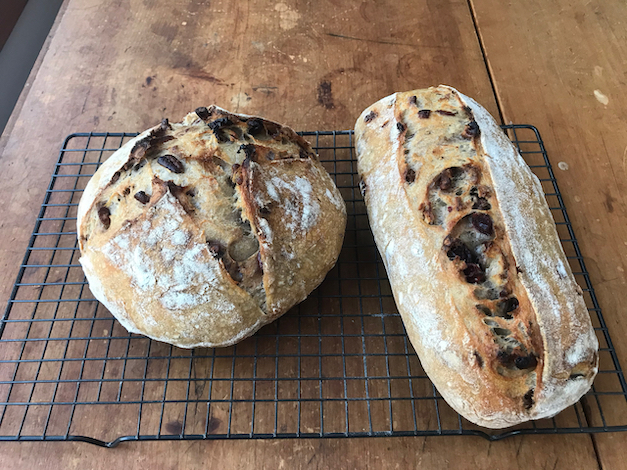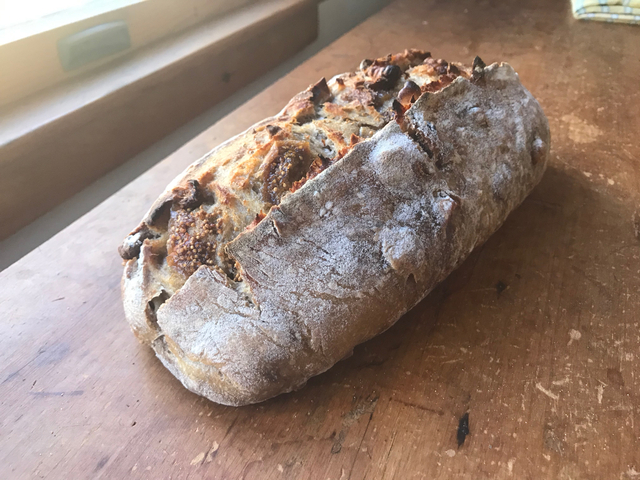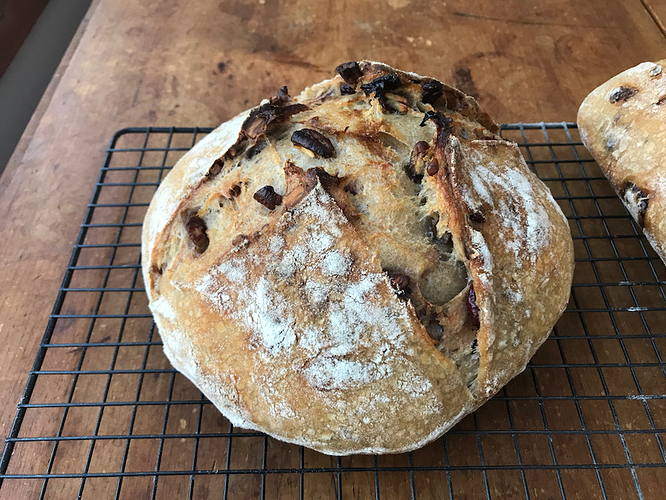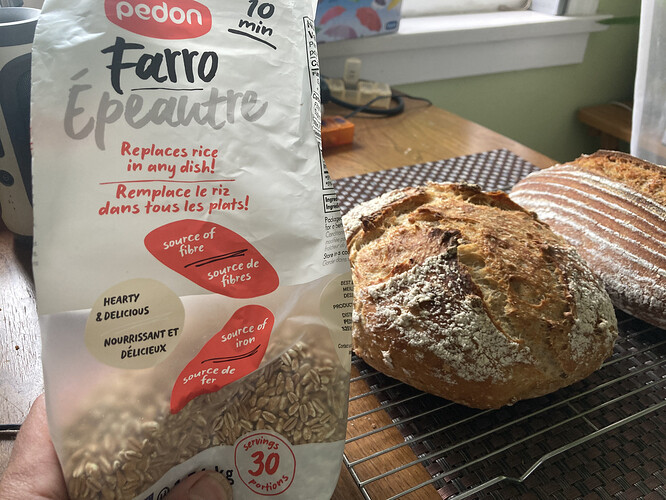Thank you Paul for taking the time to explain this process. I am glad to begin to understand what actually is happening at the various stages of bread making. Would you happen to have any recommendations for reading further on this subject? The amount and diversity of writing on sourdough is quite overwhelming, and I would welcome some suggestions.
James
I agree it is overwhelming and I’m afraid I don’t really have many specific recommendations for reading about it. In my own baking “journey” I’ve found the video tutorials here at breadtopia very helpful as a basic starting point. Eric has a very no-nonsense style of presentation which strips away a lot of what I called “hocus pocus” in the thread I linked to above. There is a series of four tutorials on this site called “Eric’s Easy Bake Series” that I thought was really great:
I think the best way to start is actually not to fill your head with too much information but just make yourself comfortable with a fairly basic process like the one in episode 1 there, or maybe like this one (which is where I started):
…and then just do it over and over and really pay attention to what is happening with the dough and how what you observe correlates with the end result you get after you bake.
I am a reader and I read a lot while I was a beginner with sourdough baking. But honestly, what I learned from all that reading was a lot less than what I learned from just baking bread over and over, and I think it actually retarded my progress in many ways. One of the mistakes I made was reading a lot of pretty advanced techniques early on and trying to use them before I really had an experiential (non-theoretical) understanding of what I was doing.
Once you get past the very beginning stages and you are consistently able to produce great bread with a simple basic method like the ones linked above, then there is certainly a lot of intermediate and advanced stuff you can find. I have found value in writings and videos by Chad Robertson (google: tartine), Trevor J. Wilson, Maurizio Leo, Josey Baker, Melissa Johnson’s recipes here at Breadtopia.
I also published a recipe / methodology here at Breadtopia for the basic whole grain bread that I like to bake:
Hi Paul,
Thanks for the suggestions. Will check out Eric’s videos again and hold the links in reserve until I have more experience. I appreciate your assistance.
James
For the parmesan loaf, that’s 7 oz by weight of parmesan? i.e. 200g parmesan? Thanks
My latest cranberry pecan loaves. Sadly these were both gifts for others, so I didn’t get to taste them nor did I see the insides. But they got great oven spring, even a bit of ears on the boule, and the color and smell were great, so I’m guessing they’re okay.
Rather than no-knead, I mixed up a double batch of the recipe minus the cranberries and pecans, let sit for an hour, then performed several stretch-and-folds in the bowl at half hour intervals. For the third S&F, I stretched the dough out on the counter to laminate and folded the cranberries and pecans in at that point. Did one final S&F in the bowl about 30 minutes later. Then left to bulk overnight, and the next morning I divided the dough, shaped and proofed the loaves, and baked at 475 F in a dutch oven and an oblong clay baker (from @breadtopia) for about 37 minutes total. I was finished around 10:30 am, so this was a project for when I don’t have to go into work (or the weekend). 
These look great. What’s your dough recipe?
Dan – My recipe hews pretty closely to Eric’s original recipe for cranberry-pecan, though with a smidge less water. I do a number of stretch and folds so this isn’t technically no-knead. Thia recipe makes two loaves.
-
650 g - white (I used half AP, half bread flour)
-
190 g - whole wheat flour (mostly freshly ground hard red winter wheat with a small amount of kamut and spelt thrown in, to finish off some nearly empty bags)
-
640 g - water
-
17 g - salt
-
120 g - 100% hydration starter (mine is a whole wheat starter - roughly
-
1 cup chopped walnuts
-
1 cup chopped cranberries
-
Including the amount of water and flour in the starter, total hydration is 78%.
Just a few days ago I made another variation on this with dried figs and walnuts, and I upped the hydration to 79% (total). That turned out great, and since the nuts and fruit absorb some of the water I think I’ll try sticking with that recipe. I think the hydration in Eric’s recipe is 80-81%.
Why do I keep making these for other people and not for myself? Here’s a fig-walnut version I made last week for a friend recovering from an illness. Thoroughly medicinal. I have not tasted the bread, but it sure smelled delicious, and the loaf got great oven spring and a nice ear. My friend kindly texted me a photo of the crumb after she cut into it. The basic dough recipe closely matches Eric’s. For this loaf, I first mixed the dough only, did two rounds of stretch and folds, and added the fruit/nuts using the lamination technique described so well by Melissa (@Fermentada). I did one more stretch and fold after that, I think.
75 g - whole wheat
25 g - rye
170 g - all purpose flour
170 g - bread flour
340 g - water
9 g - salt
60 g - starter (more or less)
1/2 cup chopped sun-dried figs
1/2 cup chopped walnuts

Gorgeous! Your laminating in additions results in remarkably evenly distributed stuff 
Susan, thanks for the quick response. Two simple questions: Was the overnight bulk at room temp or in the fridge? Also, approximately how long was the final proof and was it based on the size of the rise?
Dan - this loaf bulk fermented overnight – total bulk time from mixing until preshape was about 15 hours. I let the condition of the dough be my guide…the dough didn’t seem sufficiently “fluffy” or bubbly at 12-13 hours, the top of the dough not yet domed and smooth, so I let it bulk longer (by the way, I use a tinted pyrex bowl to bulk, not a straight-sided clear container). Also, the temps in our house are around 67 degrees, down to 64-65 during the night.
When the dough seemed ready I shaped the loaf, let it sit on the counter for about 20 minutes, and then put it into the refrigerator for about 8 hours and baked it in the evening straight from the fridge.
- preheated oven and oblong clay baker to 475,
- lowered temp to 450 after placing loaf in oven
- baked with cover on for 25 minutes, cover off for another 13 (internal temp was around 208).
I often proof at room temp and bake immediately but in this case cold proofed. I wonder if that may be part of the reason I got such a good result. l should be more systematic about this and keep better records, a la Melissa!
Melissa - I think the even distribution you are noticing is a result of both laminating in the additions early-ish in bulk ferment (though after 2 stretch and folds, and followed by one more), and the rolling method I used to shape the oblong loaf – squish/stretch the dough out into a rectangle, then roll/fold from the far end about 3-4 times, using the heel of my hand to lightly press after each roll (if that makes sense). Kinda-sorta the way demonstrated in this video beginning at 6:26: https://www.kingarthurflour.com/videos/professional-techniques/techniques-for-the-professional-baker-4-shaping
That video is excellent - thank you for sharing the link!
What I especially liked was the explanations for some things you don’t see in many videos … what fingers and thumbs are doing “underneath” the dough and why it is important.
I watched the entire video and will watch again. I’ve only recently been paying more attention to shaping and it shows particularly in the crumb.
I agree with @anon66425146 – that was a great video. Thanks for sharing.
I just wish they somehow covered how to shape Chinese steamed pork buns (bao zi). Utterly off topic though it is leavened dough. I was working on them a few months ago with an appalling lack of success despite gluing myself to YouTube!
I will be very grateful if someone can please convert the Pecan Cranberry variation into grams? Sorry forever newbie sourdougher here… 
I don’t work in cups either so have been looking up online cup conversions. Firstly every website is different and strangely enough the ounce option for the flour conversion doesn’t match anything. So here is a lovely no knead recipe I know works, which I’ll give you first, then we’ll convert it to something comparable to the original cranberry and pecan recipe.
No Knead Recipe
- 500g bread flour
- 350g water
- 10g salt
- 20g starter
- In a bowl mix the flour and salt. Make a well.
- Stir the starter into the water till fully distributed then pour the water into the well.
- Combine and form the dough.
- Bulk Ferment for 12-16 hours giving the dough one set of stretch and folds about half way through (although this can be done to your convenience).
- Once the dough is well risen, aerated, has a good matrix of bubbles and if you gently shake the bowl it jiggles then it’s done. Begin to watch it at the 12 hour mark.
- Pre-shape into a round and bench rest till relaxed then shape into a well floured banneton or prepared loaf pan and final proof till ready. About 1.5-2 hours.
- Bake.
Recipe says 16 hours but 12 seems to be closer to the right amount of time. At least for my starter.
Now let’s use that recipe as a template and convert it to a cranberry and pecan no knead with some whole wheat…
- 75g whole wheat
- 425g bread flour
- 350g water
- 10g salt
- 1/2 cup cranberries
- 1/2 cup chopped pecans pieces
- 20g starter
Since it’s a no knead just add all the dry ingredients together in a bowl. Mix. Then add the water in which the starter has been dissolved into. Combine and form the dough till there are no dry bits left. Then the rest of the recipe is the same.
Thank you Abe for sharing!
For the Steel Cut Oats recipe, I have used rolled oats instead of steel cut with very good results. I’d say it was as tasty. Where it got really good is when I used farro grains instead of oats. Its nutty flavour and chewy texture added to the taste of this bread. In each case, I lightly toasted the grains in a dry saucepan.
Cool! Was the farro you bought par-cooked? Or did you soak it after toasting?



